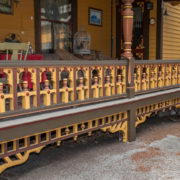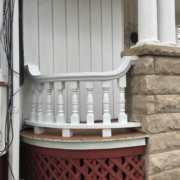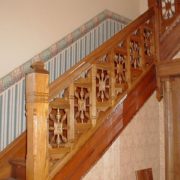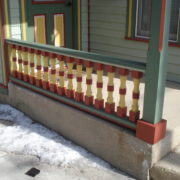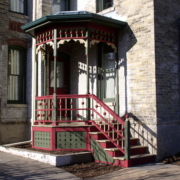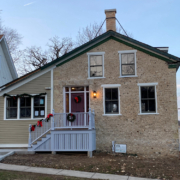Replacing rotten elements on a porch
 About 10 years ago I made replacement porch rails for 722 Douglas in Elgin. It is an intricate rail so I had a knife made to duplicate it exactly. Below is the profile. luckily I kept the knife so I could make the rail again. It is made in two pieces and then glued together.
About 10 years ago I made replacement porch rails for 722 Douglas in Elgin. It is an intricate rail so I had a knife made to duplicate it exactly. Below is the profile. luckily I kept the knife so I could make the rail again. It is made in two pieces and then glued together.

At the time I used cedar wood. Cedar has good rot resistance but it will still rot. After only 10 years the new rails rotted on their ends. A tree is designed to suck water up its length. If the end of a piece of wood is allowed to get wet it will suck the water into it. Once the water is there it will stay there and the wood will rot or attract carpenter ants. Below are the ends of the rotten rails. Once the wood is wet carpenter ants will eat it. They actually bored a one-inch diameter tunnel that is six inches deep in the one at the right.


The 10-year-old newel posts also had exposed end grain and rotted badly, as shown below. Where two pieces of wood meet the joint has to be caulked and painted or it will rot. These posts were not maintained. The joint between the stair tread and the newel post was not kept sealed allowing water in and the wood to rot.


I made new newel posts to match the old exactly I used treated wood for everything.


About three years ago I replaced a 6 inch section of the turned post because it was rotten and it broke. They did not seal the end grain when they installed the new piece so more of the old post rotted above my new section as shown on the right. I made another new turned section which was inserted into the post as shown on the left .


One of the big posts had a rotten bottom. I cut off about 10 inches and replaced it. I duplicated the bead and stop chamfer exactly.


The sawed apron boards have a framing board on the bottom. The seam between the frame and the apron boards needs to be caulked and painted. The owner did not do that so the open seam allowed water in trapping it between the boards so several of the apron boards were rotten and had to be replaced. I duplicated them exacctly.


If you have an old house porch and you see a black line showing a seam is open anywhere on the porch you need to caulk it then paint it. Use a minimum amount of caulk and make the seam neat. The best tool to spread caulk is your finger. I carry a can of water to lubricate my finger and scrape the excess caulk off of my finger after spreading it.




